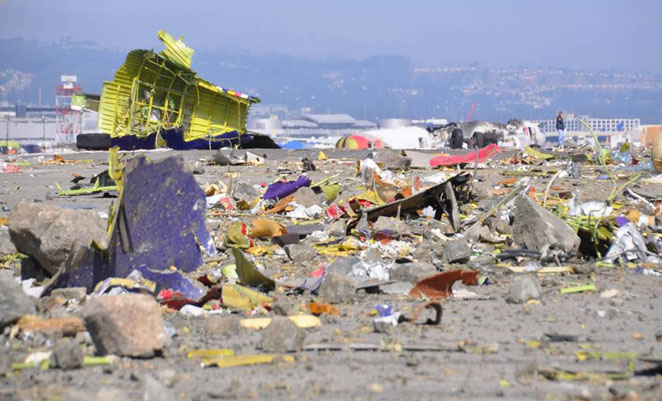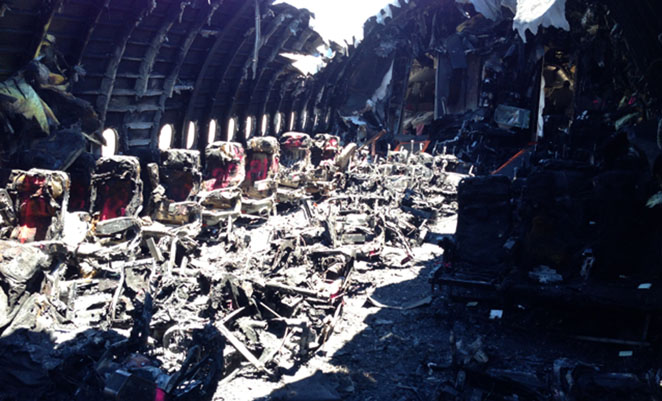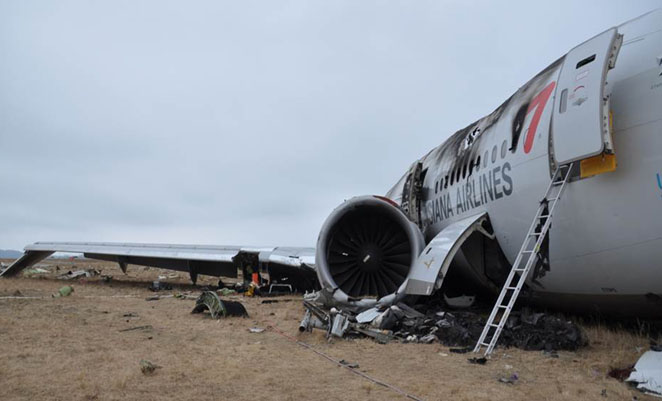
A preliminary report by the US National Transportation and Safety Board (NTSB) into the July 6 2013 Asiana Flight 214 crash at San Francisco Airport has concluded that the flightcrew’s mismanagement of the approach and inadequate monitoring of airspeed were the primary causes of the crash.
The Boeing 777-200ER was on final approach to San Francisco and undershot the runway, striking the seawall and breaking up as it cartwheeled across the runway threshold. Three of the 291 passengers and crew died as a result of the crash, and 53 were seriously injured. The impact and a subsequent fire destroyed the aircraft.

The NTSB found that the flight crew mismanaged the initial approach and that the airplane was well above the desired glide-path as much as five nautical miles out from landing. In response to this, the pilot selected an incorrect autopilot mode and took other actions that resulted in the auto-throttle no longer controlling airspeed.
As a result, the 777 descended below the desired optimum glide-path and the crew failed to notice the airspeed dropping below the approach speed or respond to the increasingly unstable approach. A go-around manoeuvre was initiated when the 777 was well below the glide-path at 100 feet, but it was too late and the airplane struck the seawall.
“In this accident, the flight crew over-relied on automated systems without fully understanding how they interacted,” NTSB Acting Chairman Christopher A Hart said in a statement. “Automation has made aviation safer. But even in highly automated aircraft, the human must be the boss.”

The report also highlighted “complexities” in the 777’s automatic flight control system and in related training and documentation, and that the pilot had an “inaccurate understanding of how the autopilot flight director system and auto-throttle interacted to control airspeed.” It said a review of the design of the 777’s AFCS could “yield insights about how to improve the intuitiveness of the 777 and 787 flight crew interfaces as well as those incorporated into future designs.”
In a statement, Boeing said it, “…respectfully disagrees with the NTSB’s statement that the 777’s auto-flight system contributed to this accident, a finding that we do not believe is supported by the evidence,” adding that, “the 777 has an extraordinary record of safety – a record established over decades of safe operation. More specifically, the auto-flight system has been used successfully for over 200 million flight hours across several airplane models, and for more than 55 million safe landings.”

As a result of the accident, the NTSB has made recommendations to the US Federal Aviation Administration, to Asiana Airlines, to Boeing, to the Aircraft Rescue and Firefighting Working Group, and to the City of San Francisco, including the need for reinforced adherence to Asiana flight crew standard operating procedures, more opportunities for manual flying for Asiana pilots, a context-dependent low energy alerting system, and both certification design review and enhanced training on the Boeing 777 auto-flight system.
An NTSB animation of the final approach can be viewed here. The report summary can be viewed here.
















Barry
says:I agree with Boeing. The 777 has had an outstanding safety record in its years in service, and one crew stuff up a landing cycle and suddenly there is a problem with the auto-flight system?
John
says:I Note ,No mention was made of the fact that SFO runway end Safety Zone is shorter than International Standards .If the Safety Zone was up to standard the Seawall would have been further out into the Bay .
Robert
says:Isn’t this the final report rather than a preliminary report? The NTSB report summary page includes “findings” and “probable cause” sections, which I thought only came with a final report (although the accompanying press release says that the full text of the report will not be published for several weeks yet).
John Harrison
says:Interesting reading, I am no expert, but isn’t modern aviation, civil aircraft in the main putting too much faith in
automated systems. Expecting the aircraft computer to sort out any problems, as they arise. Where are the
crew’s that still fly on the weekend for fun, so “keeping their hand in” so to speak. I think its a worrying trend.
Freddie
says:It would appear that the B777 is a very good and economically sound aircraft. Whilst everything points to Air Crew error there is only about point 1% that this aircraft – being so new – could have been a ‘lemon’. Personally I tend to think not as the stringent tests and checks any new aircraft undergoes would surely have picked any anomaly. Airbus had produced a few ‘lemons’ with their early production of the A320 – so something like this can happen. Unfortunately this accident is due to Air Crew error despite the length, width and breadth of the runway. Perhaps a loss of application of CRM/NTS in the flight deck is really the underlying factor. Asian operators seem to struggle with this concept.